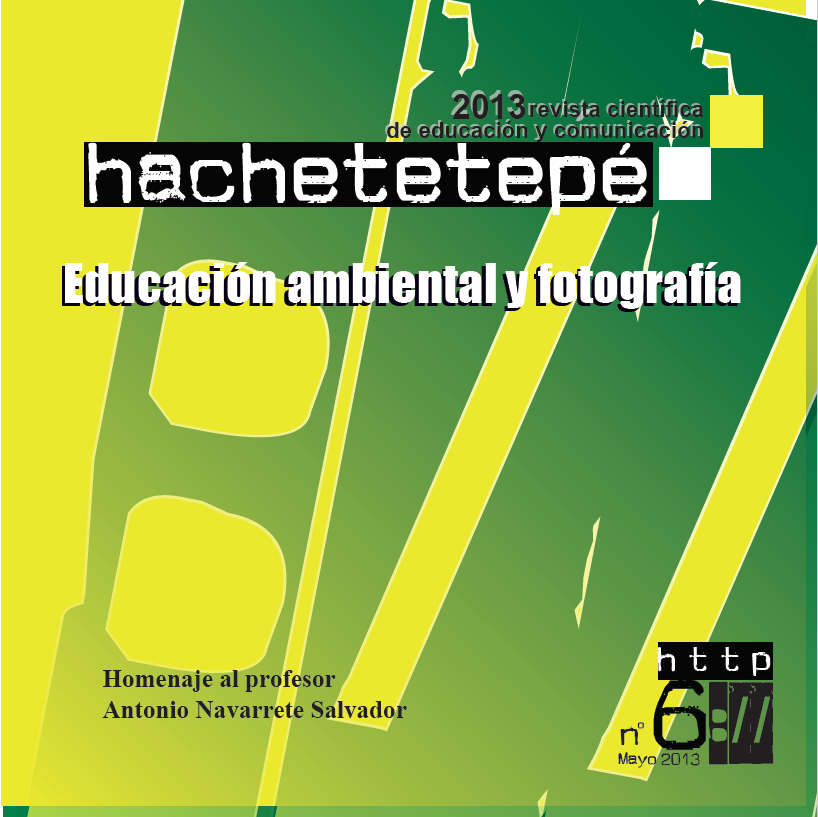Photography: From a Qualitative Research Model to Training in Environmental Education

Info
Abstract
This works begins by establishing the relevance of photography as a tool to analyze and garnish information in qualitative research. In this respect, we set out to analyze the application of photography within an educative experience which has been designed on a post-graduate course. The Master in Environmental Teaching in an inter-university programme in which various Andalucian universities participate. This Master relies heavily on information and communication technologies, and uses the virtual platform Moodle. On the other hand, it also uses virtual teaching methods through Adobe Connect Pro Meeting videoconferencing. All the campuses involved in this project can thus be connected in real time and the students can participate simultaneously in the development of the classes. The use of photography in a teaching experience at a post-graduate level shows the potential of this technique in fomenting participative, cooperative and meaningful learning.
Keywords
Downloads
How to Cite
License

This work is licensed under a Creative Commons Attribution-NonCommercial-NoDerivatives 4.0 International License.
Those authors who have published with this journal, accept the following terms:
- They will retain their copyright and guarantee the journal the right to first publication of their work, which will simultaneously be subject to the Creative Commons Attribution License . They may be copied, used, disseminated, transmitted and publicly displayed, provided that the authorship, url, and magazine are cited, and are not used for commercial purposes. No derivative works are allowed.
- They may adopt other non-exclusive license agreements for the distribution of the published version of the work (e.g., deposit it in an institutional telematic archive or publish it in a monographic volume) provided that the initial publication in this journal is indicated.
- Disseminate your work through the Internet (e.g., in institutional telematic archives or on your website) once the manuscript is accepted, which may lead to interesting exchanges and increased citations of the published work. (See The effect of open access).
Hachetetepé. Scientific journal of education and communication does not charge a fee for the submission of manuscripts or for the publication of its articles.
References
Calvo, L. (Dir.) (1998). Perspectivas en Antropología Visual. Revista de Dialectología y Tradiciones Populares. Tomo LIII. Cuaderno Segundo. Madrid: CSIC.
Casetti, F. (1989). El film y su espectador. Madrid: Cátedra.
Casetti, F. y Di Chio, F. (1991). Cómo analizar un film. Buenos Aires: Paidós.
Chen, D. T., Wang, Y. M. y Hung, D. (2009). “A journey on refining rules for online discussion: implications for the design of learning management systems”, en Journal of Interactive Learning
Research, 20 (2), 157-173.
Correa, J. M. (2005). “La integración de plataformas de e-learning en la docencia universitaria: enseñanza, aprendizaje e investigación con Moodle en la formación inicial”, en Revista Latinoamericana de Tecnología Educativa, 1 (4), 37-48.
Deleuze, G. (1985). La imagen-Tiempo. Estudios sobre cine 2. Buenos Aires: Paidós.
Derrida, J. (1997). Cómo no hablar y otros textos. Barcelona: Proyecto A.
Estrada, L. I., Tójar, J. C. y Matas, A. (2010). Evaluación de una experiencia blended learning. Un nuevo enfoque curricular en la Educación Ambiental. I Encontro Internacional TIC e Educação. (pp. 369-374). Lisboa: Instituto de Educação.
Gauldreault, A. y Jost, F. (1990). El relato cinematográfico. Cine y narratología. Buenos Aires: Padiós.
González Mariño, J. C. (2006). “B-learning utilizando software libre, una alternativa viable en Educación Superior”, en Revista Complutense de Educación, 17 (1), 121-133.
Lisón, (Coord.). (1999). “Antropología Visual Española”, en Revista de Antropología Social, 8.
Mcluckie, J. A., Naulty, M., Luchoomun, D. y Wahl, H. (2009). “Scottish and Austrian perspectives on delivering a Master’s: From paper to virtual and from individual to collaborative”, en Industry and Higher Education, 23 (4), 311-318.
Rodríguez Gutiérrez, M. (1985). “Testimonio y poder de la imagen”, en A. Aguirre (Ed.) Etnografía. Metodología cualitativa en la investigación sociocultural. Barcelona: Marcombo; 237-247.
Ruby, J. (1996). “Visual anthropology”. En D. Levison y M. Ember (Eds.). Encyclopedia of Cultural Anthropology. Vol. 4. Nueva York: Henry Holt Company.
Sontag, S (1989). Sobre la fotografía. Barcelona: Edhasa.
Tójar, J. C. (2006). Investigación cualitativa. Comprender y actuar. Madrid: La muralla.
Tójar, J. C. (2010). “Apuntes de metodología participativa para el análisis de roles y relaciones en comunidades indígenas de la Amazonía Venezolana”. En J. C. Tójar (Coord.). (2010) Cooperación internacional e investigación educativa. Acción y colaboración en el desarrollo social. Sevilla: Infornet; 111-119.
Tójar, J. C. (2011). “Investigación cualitativa en educación”. En S. Nieto (Coord.). Principios, métodos y técnicas esenciales para la investigación educativa. Madrid: Dyckinson; 403-424.
Tosi, V. (1993). El lenguaje de las imágenes en movimiento. Barcelona: Grijalbo.
Vilches, L. (1986). La lectura de la imagen. Barcelona: Paidós.
Worth, S. (1981). Studying visual communication. Filadelfia: University of Pennsylvania Press.

